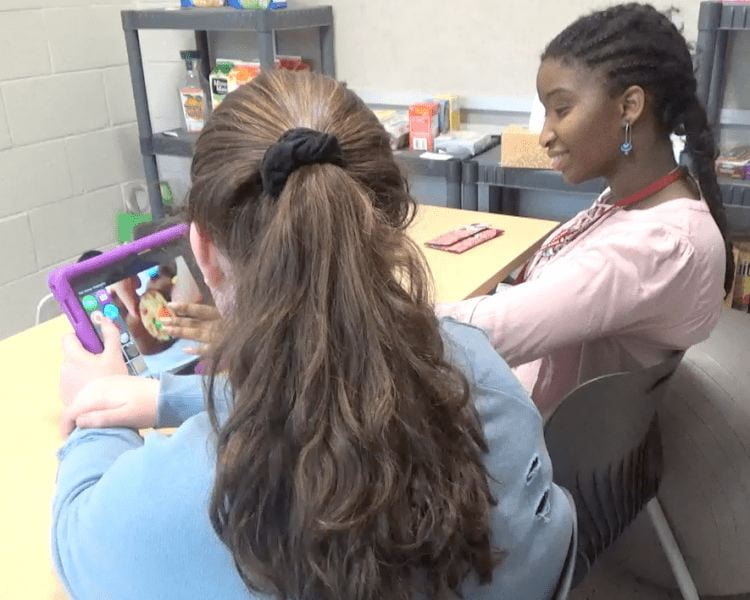
A video visual scene display (VSD) approach combines the participation supports of video prompting with the communication supports of VSDs (Light et al., 2019). Using a specialized app, VSDs can be placed within a video – that is, the video plays, and then pauses to show a VSD. The appearance of the VSD acts as a cue to perform the behavior depicted in the video, and the VSD can also be programmed with hotspots to support communication. The hotspots in the VSDs can be used in two ways: some persons with complex communication needs use the speech output of the AAC device to communicate with others, while others use the speech output to cue use of their own speech in the interaction (O’Neill, Light, & McNaughton, 2017)
The use of video VSDs is an important enhancement of video modeling and provides integrated supports not only for learning new skills, but also for communication (Light, McNaughton, & Jakobs, 2015). The VSDs are programmed to appear at key moments in the video; these pauses at key junctures mark the appropriate opportunity for participation and communication, and the hotspots in the VSD provide the necessary vocabulary for the learner with complex communication needs to fulfill the communication demands at that point in time.
See https://tinyurl.com/rerc-on-aac-vVSD for an example of video VSDs.
Through research and development partnerships with the RERC on AAC, a video VSD approach is now supported in two commercially available software app

GoVisual, available from the Attainment company

Scene and Heard Pro , available from Therapy Box
Published Research

Chapin, S. E., McNaughton, D., Light, J., McCoy, A., Caron, J., & Lee, D. L. (2022). The effects of AAC video visual scene display technology on the communicative turns of preschoolers with autism spectrum disorder. Assistive Technology, 34(5), 577-587.
Laubscher, E., Raulston, T. J., & Ousley, C. (2022). Supporting peer interactions in the inclusive preschool classroom using visual scene displays. Journal of Special Education Technology, 37(2), 318-326.
Babb, S., Jung, S., Ousley, C., McNaughton, D., & Light, J. (2021). Personalized AAC intervention to increase participation and communication for a young adult with Down syndrome. Topics in Language Disorders, 41(3), 232-248. https://doi.org/10.1097/TLD.0000000000000240

Babb, S., McNaughton, D., Light, J., & Caron, J. (2021). “Two friends spending time together”: The impact of video visual scene displays on peer social interaction for adolescents with autism spectrum disorder. Language, speech, and hearing services in schools, 52(4), 1095-1108.
Babb, S., McNaughton, D., Light, J., Caron, J., Wydner, K., & Jung, S. (2020). Using AAC video visual scene displays to increase participation and communication within a volunteer activity for adolescents with complex communication needs. Augmentative and Alternative Communication, 36(1), 31-42. doi:10.1080/07434618.2020.1737966
Babb, S., Gormley, J., McNaughton, D., & Light, J. (2019). Enhancing independent participation within vocational activities for an adolescent with ASD using AAC video visual scene displays. Journal of Special Education Technology, 34,(2), 120-132.
Laubscher, E., Light, J., & McNaughton, D. (2019). Effect of an application with video visual scene displays on communication during play: Pilot study of a child with autism spectrum disorder and a peer. Augmentative and Alternative Communication, 35(4), 299-308.
Caron, J., Holyfield, C., Light, J., & McNaughton, D. (2018). “What have you been doing?”: Supporting displaced talk through augmentative and alternative communication video visual scene display technology. Perspectives of the ASHA Special Interest Groups, 3, 123-135. doi:10.1044/persp3.SIG12.123
Last updated: May 27, 2024